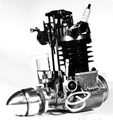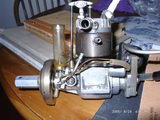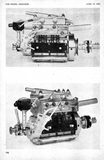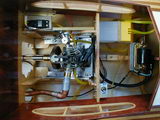| Name | Gannet 15 | Designer | G A Nurthen |
| Type | Four-stroke, spark ignition | Capacity | 15 cc |
| Production run | unknown | Country of Origin | England |
| Photo by | Eric Offen, Tim Dannels | Year of manufacture | 1958-circa 70 |
Background
Being the webmistress and author of most of the material on this site, I receive a regular stream of emails from people who optimistically think I may actually know the answer to their questions. Sometimes I do, and if not, I generally know someone who does. All this is leading to the subject in question here, namely the Gannet. This engine generates a remarkable number of emails asking after provenance which hopefully, this page will satisfy.
In 1958, Model Maker magazine launcehed a new, semi-regular column to review marine engines of all types. The subject of the first review was the Gannet 15 manufactured by Nurthen & Muirhead of 200 Belsize Road, Kilburn, London. [1]. The article concluded with a note that the company planned a 30cc Gannet Twin and included a photograph of an obviously advanced prototype.
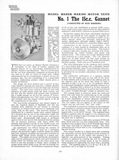 |
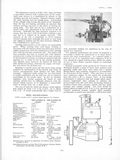 |
Ten years later, Model Maker had morphed into Model Cars and Model Boats with Peter Chinn conducting engine reviews for the latter. His 1958 review of the Gannet now listed the manufacturer as Gannet Engineering Ltd of Kent, England [2].
The designer and builder of the engines was Mr George A Nurthen. During the period 1949 through 1952, Nurthen had published occasional articles in the Model Engineer on the design and construction of marine powerplants, both steam and IC (two and four-stroke). His last contribution to the magazine was a quite attractive 24cc twin in-line cylinder side-valve engine. The article showed two identical engines, timed for opposite rotation. Sadly, only a few dimensioned parts were shown.
![]() The crankshaft was fabricated from seven parts. As can be seen from the drawing, the pistons will move in unison, unlike in-line two-strokes (such as the Chunn Twin) which generally have opposed piston movement to even out the power strokes. However, being a four-stroke, the Gannet can still be timed for alternate firing, thus providing one power stroke per revolution. This scheme is not unusual in four-strokes of this type as while it requires higher vibration damping, it eliminates the rocking moment that is induced when the pistons move in opposite directions.
The crankshaft was fabricated from seven parts. As can be seen from the drawing, the pistons will move in unison, unlike in-line two-strokes (such as the Chunn Twin) which generally have opposed piston movement to even out the power strokes. However, being a four-stroke, the Gannet can still be timed for alternate firing, thus providing one power stroke per revolution. This scheme is not unusual in four-strokes of this type as while it requires higher vibration damping, it eliminates the rocking moment that is induced when the pistons move in opposite directions.
Ron Warring (reference [1]) gives the sole, world-wide distributor as RipMax. The engine featured infrequently in their regular advertisements. Only the Gannet water-cooled single was featured and no price was quoted for the engine, even though other items in the same adds carried price details. Ten years on, infrequent adds for the Gannet (still omitting pricing information) were appearing from Lancashire distributor, Roland Scott Pty Ltd. It appears that no direct advertising was ever undertaken. This is understandable as the engine was well known by the boating fraternity, with demand probably matched to supply.
Versions
In addition to the water-cooled single, an air-cooled version was also available (see the picture at the top of the page provided by ECJ editor, Tim Dannels). This version was produced in significantly less numbers than the water-cooled variant and not surprisingly, omitted the magneto.
Even rarer was the twin cylinder version which was based on a magnesium crankcase with ball-race main bearings. These engines are quoted in reference [1] as being made to order only and are quite rare. The pristine example pictured below is from the collection of Mr Eric Offen. Note the separate water pump driven off the "back" end of the engine. This is about the only feature the engine shares with the earlier Nurthen side-valve design.
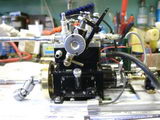 |
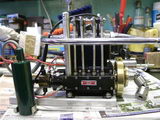 |
In addition to these, there is strong evidence that at least one horizantal opposed twin "GAN" was built.
Description
The 15cc single cylinder four-stroke pictured here was the most common model. The most prominent distinguishing feature is the raised letters GAN on the crankcase. The 15cc engine had a bore of 1.0625" and stroke of 1.030" (measured by PGF Chinn), giving a total displacement of 0.913 cuin (14.96cc). The incorporation of a magneto to provide the voltage for the spark, and a drip feed lubrication system made for compact, self-contained unit ideal for prolonged marine use. Although Gannet Engineering was a small operation, George Nurthen made sufficient engines that they are not all that uncommon in England, even today.
The scans below of Peter Chinn's review will answer detailed questions better than any misguided ramblings of mine. If you are viewing them under Microsoft's IE, it will helpfully reduce them to a size where they are unreadable. Sometimes, it pops up a button to let you see them at the size I intended them to be (rant mode off)...
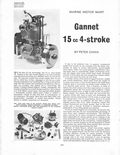 Page 278 |
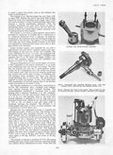 Page 279 |
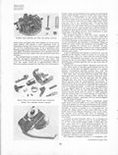 Page 280 |
 Page 293 |
Conclusions:
A robust, well made marine power-plant which can probably be called the first commercially successful British model four-stroke (the Channel Island Special having failed to capture a market despite being a well-made engine).The engine continues to generate considerable enthusiasm in England, being the ideal choice for a modeller building a vintage design like the Sea Queen. The definitive story of George Nurthen and his engines was the subject of a very detailed and well researched series of articles by David Wiggens that appeared in Model Boats in 1993.
References:
| [1] | Warring, R: Marine Motor Tests No. 1: The 15cc Gannet, Model Maker, Model & Allied Press Ltd, England, Volume 8, Number 89, April 1958, p170. |
| [2] | Chinn, PGF: Gannet 15cc 4-stroke, Model Boats, Model & Allied Press Ltd, England, Volume 18, Number 211, June 1968, p278. Click here for the review text. |
![]()
